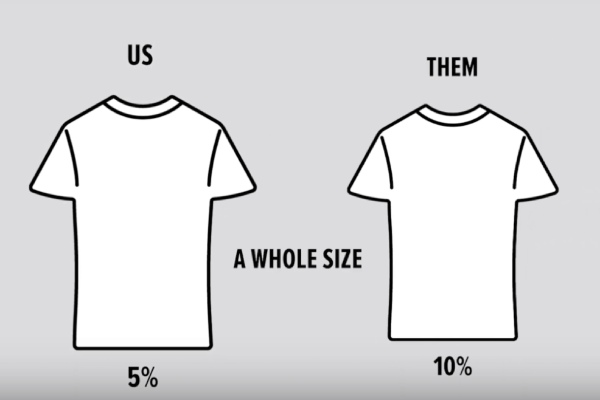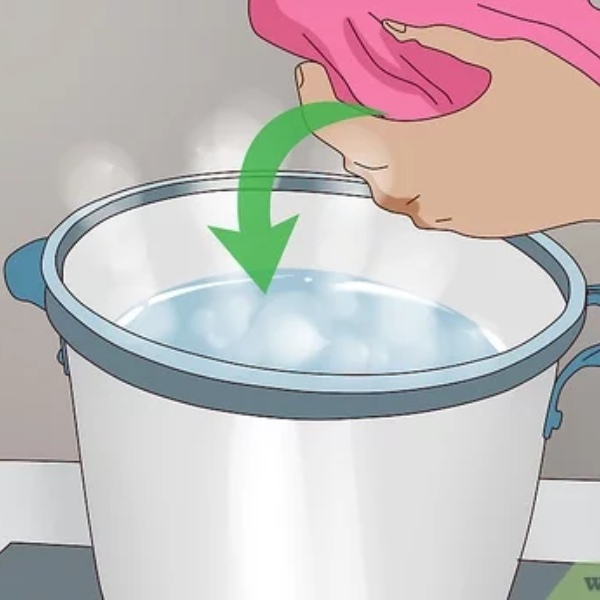Shrinking clothes is like crafting a masterpiece, preserving their shape while enhancing their fit. People adore shrinking garments to tailor them perfectly, particularly those oversized or baggy pieces, adding a touch of comfort and style.
Beyond the snug fit, shrinking also acts as a magic wand, removing extra dye and chemicals from clothing, making it safer and more comfortable to wear. Furthermore, it is a secret weapon against wear and tear, tightening fibers to prevent sagging or stretching. Overall, shrinking clothing is a desirable art that seamlessly improves fit, comfort, durability, and style.
In this article, we will share advice and tips from laundry experts on how to shrink clothes, how to wash them, and whether it’s better to let them air dry or use a machine to shrink them on purpose.
Unlocking the Secrets: Factors to Consider Before Shrinking Clothes
Usually, you don’t want your clothes to shrink when you wash them. But sometimes, you need to make them smaller on purpose. Maybe you accidentally bought something too big, or you found a great deal on jeans that are a bit loose.
Or maybe you lost weight and want your clothes to fit better without buying new ones. You might also just want to fix some stretched-out clothes. It is possible to make your clothes smaller, but you have to do it carefully to avoid damaging them.
Before you try shrinking your clothes, there are some things you should think about to make sure you get the result you want. Here’s what you need to know.
Fabric Selection and Understanding

Fiber type and garment quality can affect how they shrink. Some fabrics shrink more than others. Materials like cotton and wool are more likely to shrink than materials like polyester or nylon. Knowing what your clothes are made of helps you pick the right way to shrink them without ruining them. Sammy Wang, a scientist at Downy, says clothes with natural or man-made fibers, like cotton, linen, wool, and rayon, are more likely to shrink because they soak up water well. She says,
“Garments with synthetic fibers, such as polyester and nylon, are less likely to shrink,”
Follow care label instructions
Always read the care label on your clothes. Manufacturers give instructions on the label on how to wash and dry them to keep them nice. If it says the clothes are already “pre-shrunk,” they won’t get smaller. And if it says “dry clean only,” don’t put it in the washing machine. Following these instructions, your clothes won’t be damaged when you try to shrink them. Wang says,
“Because of all of the variables in garments, it’s difficult to control or predict the shrinkage and damage when intentionally shrinking clothes at home, but shrinkage in garments can be up to a 10% change in dimensions, so there’s a pretty wide range of what you could experience when intentionally shrinking clothes at home,”
Quality of clothes
Before shrinking clothes, it is essential to consider their quality. Better quality clothes are less likely to shrink. They are usually made from better materials and put together with stronger stitching, so they don’t get damaged easily when they shrink. But lower-quality clothes might not hold up as well and could get misshapen or torn. Mary Gafloardi, an in-house scientist and cleaning expert from Clorox, says,
“Special finishes and production techniques that prevent shrinkage are often used by better quality manufacturers because most people don’t want their clothing to shrink. They want to be able to wash it and wear it again and again and have it look the same as when they bought it”
Tension

Before shrinking clothes, it is important to consider tension. Tension refers to how tight the fabric gets stretched when you wash and dry it. High tension can make clothes shrink too much or even change their shape. Gafloardi exemplified,
“Yarns that are stretched tight during fabric construction will reduce in size once they get wet unless a finish is applied to prevent this. As with yarn, fabric that was held under tension during production will relax when it gets wet, in a process known as relaxation shrinkage. In general, if a garment is going to have any relaxation shrinkage, you will see most of it the first time the garment is washed.”
Methods to shrink clothes
The straightforward process of shrinking clothes is to wash the clothes with hot water and then dry them using a high-heat setting. But the method might change depending on what the clothes are made of. Here are some usual steps typically followed to shrink clothes effectively,
Hot water wash
Using a hot water wash is a common method to shrink clothes. Simply set your washing machine to a hot water cycle and wash the garment, which can cause the fabric fibers to contract and shrink, especially if they are made of natural materials like cotton or wool. But be careful not to use this with delicate fabrics because it might damage clothes. After washing, you can put the garment in the dryer on a high-heat setting to help it shrink even more.
High Heat Dryer
After you wash your clothes, place them in the dryer and select a high-heat setting. This can cause the clothes to shrink, especially if they are made of materials like cotton and denim. Let the clothes dry on high heat for approximately 60 minutes, checking them every five minutes to see how much they are shrinking. It is important to monitor the drying process to prevent them from shrinking too much or damaging delicate fabrics. Once the clothes reach the size you want, take them out of the dryer right away to prevent them from shrinking too much.
Boiling
Boiling is another way to shrink clothes, especially small items like cotton socks or underwear. To shrink clothes using this method, fill a pot with water and bring it to a boil. Then, put the clothes in the boiling water and let them soak for around 30 minutes. Make sure to watch them closely to avoid damage. After soaking, take the clothes out of the water and let them cool down. Then, rinse them with cold water.

Steam Treatment
You can shrink clothes by using a steam iron or garment steamer to apply heat and moisture directly to the fabric. Hang the garment on a hanger and move the steamer or iron over it evenly to make sure it shrinks evenly. Focus more on the areas where you want more shrinkage. After steaming, let the garment cool and dry naturally. This method is gentle and good for fabrics that might not handle traditional shrinking methods well.
Wet Stretching
You can shrink clothes by wet stretching them. First, soak the garment in cold water until it’s wet. Then, gently stretch the fabric in the areas where you want it to shrink while it’s still damp. After stretching, let the garment air dry completely. As the fabric dries, it will shrink and take on the stretched shape. This method lets you control how much the clothes shrink and is good for making small size adjustments.
Repeated washing and Drying
You can shrink clothes gradually by washing and drying them multiple times with hot water and high heat. This works well for different fabrics like cotton and denim. To get the best shrinkage, wash and dry the garment several times, checking how much it’s shrinking after each time. But be careful not to let delicate fabrics shrink too much or get damaged. After some time of washing and drying, the clothes will gradually become smaller until they fit how you want them to.
Frequently Asked Questions
1. Why would I want to shrink my clothes?
Usually, you don’t want your clothes to shrink when you wash them. But sometimes, you need to make them smaller on purpose. Maybe you accidentally bought something too big, or you found a great deal on jeans that are a bit loose. People adore shrinking garments to tailor them perfectly, particularly those oversized or baggy pieces, adding a touch of comfort and style.
2. What are the common factors that determine whether clothes can be safely shrunk?
Before you try shrinking your clothes, there are some things you should think about to make sure you get the result you want. These include selecting the appropriate fabric, following care label instructions, assessing the quality of the clothes, and understanding tension.
3. Can I shrink clothes without using a dryer or hot water?
Yes, you can shrink clothes by using a steam iron or garment steamer to apply heat and moisture directly to the fabric.
Also read, Fabric Care 101: When to Choose Dry Cleaning and How It Works
